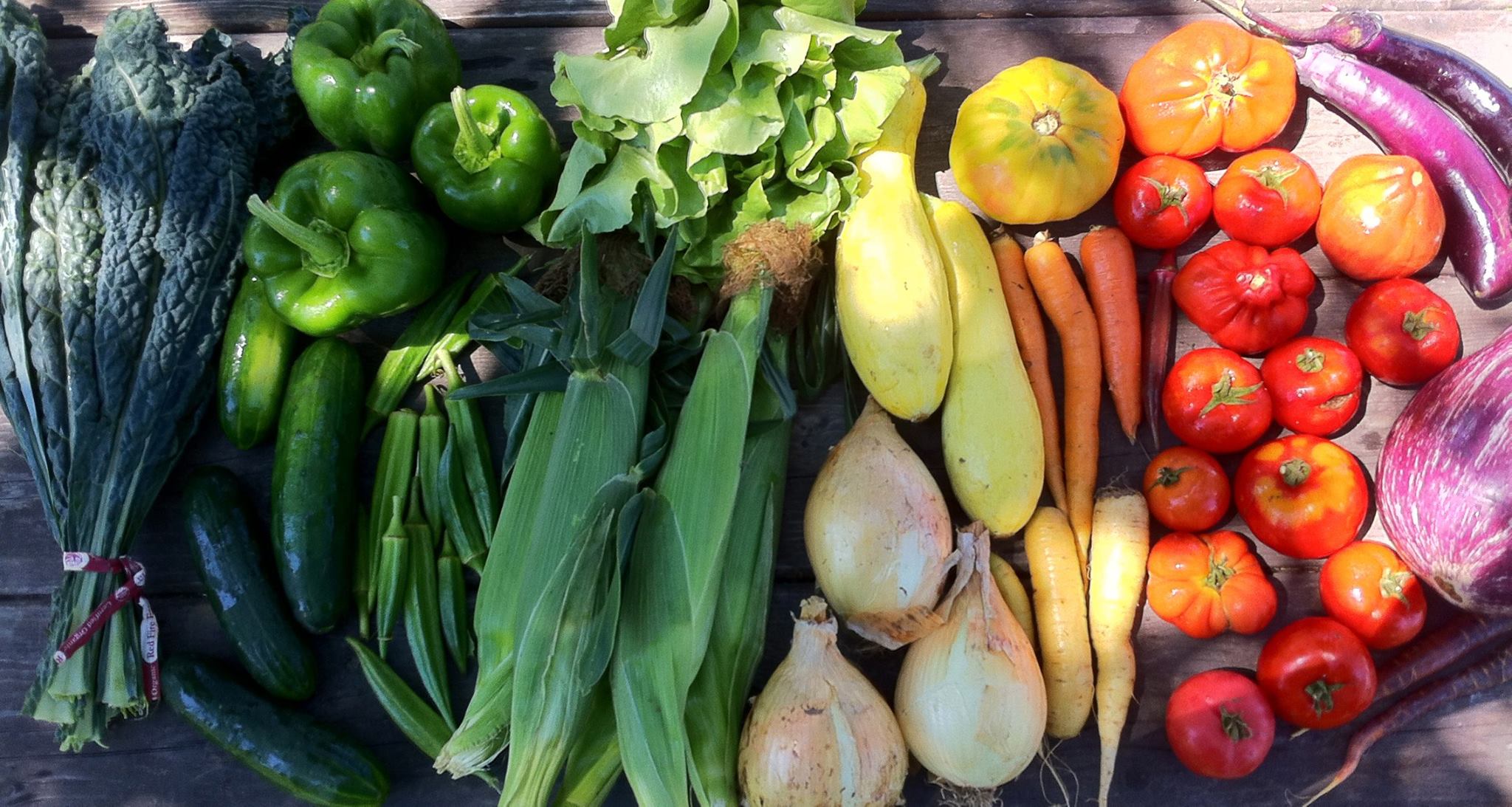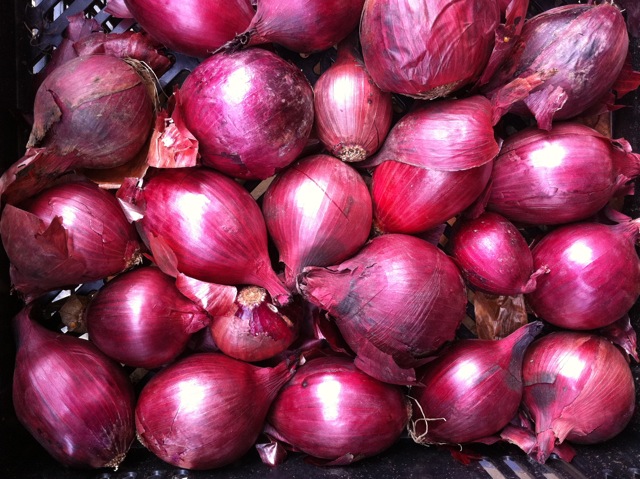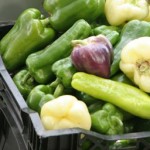
Peppers
The Basics
We grow a wide variety of peppers, from long sweet Italian frying types to the classic chunky bells. Did you know that green peppers are a less ripe version of a red or yellow pepper? If you let a green pepper stay on the plant, it will ripen further into a colorful pepper. We have peppers that ripen into varied hues from yellow to orange to red, even chocolate brown. We also have some peppers that are white or purple at their “green” stage.
Storage Tips
Wrap loosely in the fridge. Try to keep them dry, as moisture will cause them to rot sooner. Green peppers will last a few days longer than yellow or red.
Peppers are the easiest thing to freeze, just chop them up and put in a bag and freeze. Then you can take them out and throw them in anything all winter. You can also roast them. Same deal for hot peppers as for sweet.
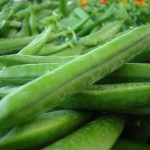
Peas
The Basics
We grow several types of spring peas: shelling, sugar snap, and snow peas.
Snow pea pods are very flat, with extremely small peas inside. Eat the whole pod!
Sugar snap pea pods have large peas inside, with a thick, crunchy pod. These pods are also delicious whole.
Shelling peas have a thick, inedible pod with very large peas inside. Remove the peas from the pod, discard the pod, and dry or cook the peas immediately.
In the early spring, we also sell pea tendrils (the baby pea plants before they produce any pods). These are an extremely tasty delicacy– you can nibble on them raw or do a quick saute.
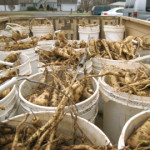
Parsnips
The Basics
If you’ve never had these, get excited. They are sweet and so yummy — sweeter and nuttier than carrots. The first round of parsnips are harvested in the fall, but we save some in the ground over winter. These parsnips are dug in the spring and have an even higher sugar content. The cold of winter makes the parsnips convert some of their starches into sugars, making them even more delicious.
In medieval times, parsnips were as much of a staple as potatoes. Sugary varieties were also often fermented to make wine. High in potassium and vitamin C.
Cooking Tips
Try mashed parsnips with a little honey, roasting them with other root veggies, making parsnip “fries,” or replacing carrots for parsnips in any of your other recipes. Parsnips are a great replacement for carrots in carrot cake!
Storage Tips
They store much like carrots in cool and humid places. For short-term storage, keep bagged in the refrigerator for up to a few weeks.
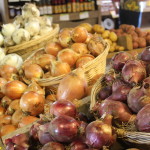
Onions
The Basics
We grow several types of onions, including pearl onions, Ailsa Craig sweet onions, and storage types.
Pearl onions appear first in the springtime. Use anywhere you’d use regular onions. They have a slightly milder flavor that’s great for sandwiches and salads. And you can use the green tops like scallions! Just chop them up and saute them a couple minutes with whatever you’re cooking. Roasting them whole is delicious.
Ailsa Craigs have the characteristics of a sweet, Spanish-type onion. Ailsa Craig onions take their name from an island off the coast of Scotland. They do well in our cool New England weather. They’re sweet and not for storing long-term. Delicious raw on tomato sandwiches, added to salads, and caramelized. The greens are a little tougher than the pearl onion greens, and more suited to flavoring soups and stocks. You could try them in a saute too and see how they cook up.
Our storage onions, red and yellow, are harvested in early fall and dried out in our greenhouses.
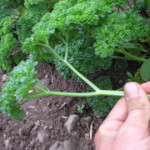
Parsley
The Basics
We grow two types of parsley. Italian flat leaf parsley has a slightly stronger flavor and flat leaves, a favorite of chefs. Curly parsley is perhaps the more well known variety with big poofy leaves that keep a nice loft when chopped. Both are great for any recipe that requires parsley. Fresh herbs can make your sandwiches more delicious too, so don’t be afraid to add a few leaves of parsley.
Storage Tips
Keep in the refrigerator in a plastic bag. For longer keeping, put stems in a cup of water and cover with a plastic bag.
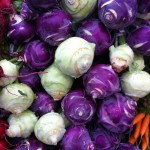
Kohlrabi
The Basics
We grow kohlrabi during a large part of the year. Younger kohlrabi in the springtime is smaller, sweeter, and comes with the greens attached. Kohlrabi that we harvest in the fall and store overwinter is larger and firmer.
Cooking Tips
This crazy looking vegetable comes in both purple and green, but there are no discernible differences in flavor. Peel and slice up the bulb thin and raw for salads. You can cook the bulb too in a stirfry, soup, or any style you like. Make sure to remove the woody skin before preparing.
If the leaves are attached, you can use them similarly to kale.
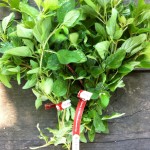
Oregano
The Basics
Oregano is a member of the mint family, and shares some similar flavor characteristics with mints and other relatives like basil, lavender, marjoram, and sage. The taste profile of oregano includes sweet and bitter notes with a deep warming aromatic flavor. Oregano also has numerous health benefits, specifically for its antibacterial and antioxidant properties, so love it up and use it often!
Cooking Tips
Oregano pairs well with beans, eggplant, and tomatoes. Try it in salad dressings or marinades with lemon and garlic, in any type of tomato sauce, or as a flavoring for beans.
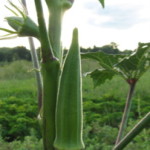
Okra
The Basics
Okra is used in a wide variety of cuisines around the world, from Ethiopia to Bangladesh to New Orleans. The okra plant can grow up to six feet tall, and have white blossoms. We harvest our okra when they are small and tender– if they grow too large, they become woody and tough.
Cooking Tips
Trim off the stem end and chop into any shape you want, toss into a stir fry, and enjoy. Coat lightly in olive oil and roast in the oven, by itself or with other summer produce.
Also good in soups, gumbo-like dishes, and more. It creates something of a gelatinous texture that gets into the sauce and is very soothing to eat.
Mint
Mint comes in many variations with layers of flavor that add to the bright cooling flavor of mint. You can make simple infused water with mint to enjoy in the summer by crushing leaves in your hand and adding them to cold water. Or a warm tea in the fall by steeping sprigs in boiling water. Mint is a common herb in Middle Eastern cuisine – try making a yogurt sauce with cucumber and mint to go along with spicy foods. It pairs well with carrots, peas, watermelon, hot peppers, and cucumbers.
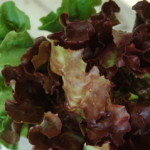
Lettuce
The Basics
We grow many types of lettuce, from green frilly heads to deep dark oak leaf to the wonderful red and green New Red Fire. Salads with fresh lettuce are very refreshing in the summer season, and in the winter too, when green is scarce.
Cooking Tips
A simple salad of lettuce and one other ingredient, like thinly sliced radishes, can be wonderful. So can the all-out everything salads with raisins, cheese, chopped carrots, cherry tomatoes, walnuts, chopped herbs, and whatever you have on hand.




